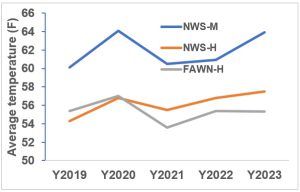Qingchun Liu, Teresa Olczyk, and William R. Lusher
Ornamental productions in Miami-Dade County are concentrated in the Homestead area, the southwest corner of the County. During the wintertime, particularly from late December through January, the temperature occasionally could drop to below 40 °F, which can cause irreversible damage to the tropical and subtropical plants without further protection.
When a strong cold front is forecasted to affect Miami-Dade County, nursery growers are on alert about the potential occurrence of near-freezing temperatures during the night. When such a low temperature is at a critical point, growers need to decide whether to turn on the overhead irrigation to protect their high-valued plants. Growers can either set up thermometers at their nurseries to monitor the temperature onsite, or they can check on current temperatures provided by public weather services.
There are two public weather information available for nursery growers in the Homestead area: the National Weather Service (NWS) and the Florida Automated Weather Network (FAWN). Though Homestead is geographically very close to Miami, the temperature data in January for the Miami area is very different from that for the Homestead area, particularly when the lowest temperature is the concern regarding cold protection (Fig. 1). When looking at the temperatures for the Homestead area, the weather data from two sources were relatively close; however, the readings from FAWN were relatively lower than those from NWS, particularly in the last three years (Fig. 1).
Cooler air sinks during a cold event, so air temperature closer to the ground will reflect real conditions where ornamental plants are in the nurseries. This is critical for growers when they are monitoring the temperature as it drops to near freezing. Within the last two winters, the weather station from FAWN recorded lower minimum temperatures than that of NWS for the Homestead area regarding the dangerously low temperatures for the plants (Fig. 2).
In summary, FAWN may be a better source for more accurate low temperatures during an extreme cold event when nursery growers in Miami-Dade County need it for decision-making on whether to turn on the overhead irrigation to protect the valuable ornamental plants through the coldest period.
Figure 1. Average lowest temperatures recorded for the Miami area (M) and the Homestead area (H) in January from 2019 to 2023 through the National Weather Service (NWS) and Florida Automated Weather Network (FAWN). The temperature data from FAWN were the ones recorded at 60 cm above ground located at the University of Florida Tropical Research and Education Center in Homestead.
Figure 2. Near-freezing temperatures recorded in the last three years for the Homestead area through the National Weather Service (NWS) and Florida Automated Weather Network (FAWN).
Source: UF/IFAS Pest Alert
Note: All images and contents are the property of UF/IFAS.

 Fig. 1
Fig. 1 


